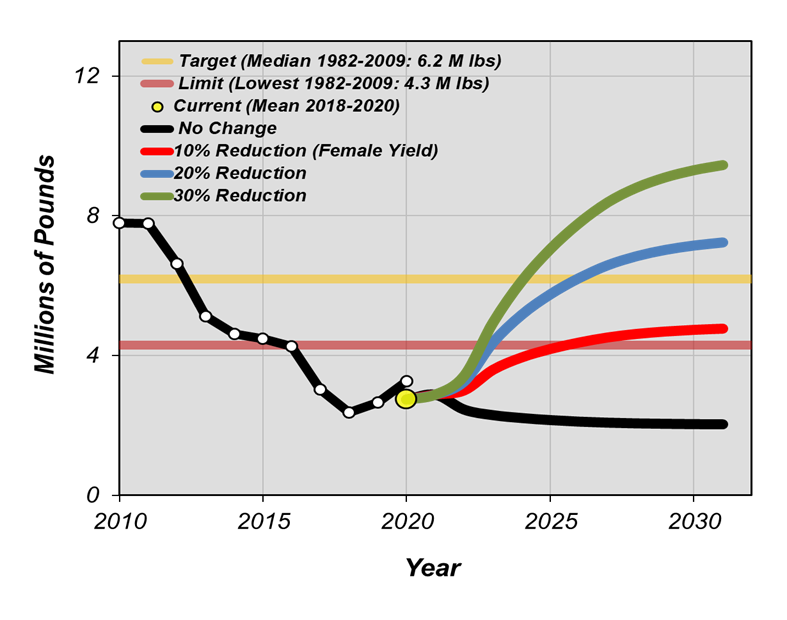Hot Topic: Spotted Seatrout
NEW REGULATIONS EFFECTIVE NOVEMBER 20, 2023
What are the new regulations?
13-inch total length to 20-inch total length slot/15 creel, with two fish over 20 inches total length allowed within (not in addition to) the 15 fish creel. Elimination of the charter guides and/or their deckhands creel limit while conducting a for-hire trip. Charter guides and deckhands may participate in fishing activity, but their bag limit of spotted seatrout is zero and they may not harvest spotted seatrout on a charter trip. A sunset (go back to previous regulations) for the new regulations on January 1, 2028, unless regulations are modified prior that date.
What is the status of spotted seatrout?
The most recent stock assessment of spotted seatrout completed in 2021 shows that Louisiana’s spotted seatrout stock has been overfished since 2016. The definition of overfished is based on the history of the size of the stock as analyzed in the assessment (1982-2020). The overfished limit is set at the lowest level of spawning stock biomass (weight of mature females) in the history of the assessment.
The stock assessment incorporates data from LA Creel, LDWF's recreational landings data collection program implemented in 2014. LA Creel provides improved data that allows fishery biologists to more accurately assess the status of the stock due to the precise, basin-level data. The stock assessment still uses MRIP recreational landing data for years prior to 2014 to provide long-term harvest estimates; these data have been calibrated to LA Creel data to make the harvest estimates compatible. Combining these data with data from field sampling (1986-present) and biological sampling of harvested fish (2002-present) shows that fishing rates were too high (overfishing) in 6 of the past 10 years and that spawning stock biomass has been declining since 2009 and is currently at the lowest level observed since LDWF has been assessing the stock. Data also indicate that the proportion of females age 3 and older has been declining since about 2012 and is at the lowest level observed in the assessment history; losing diversity in age in the population decreases the population’s resilience. Despite the recent decrease in recreational spotted seatrout landings, fishing effort continues to rise.
How do we rebuild the stock?
When overfishing occurs or a stock becomes overfished, LDWF fishery biologists recommend measures to the Commission on how much change in harvest is needed to bring fishing rates and/or the population back to target levels. In September 2019 and November 2021, LDWF presented the latest stock assessments to the Commission. At the January 2020 and November 2021 meetings in 2020, 2021, 2022, and 2023, LDWF fishery biologists presented several management scenarios along with LDWF’s goal for stock recovery. The scenarios presented to recover the stock included:
- Creel limit only
- Size limit only (including slot limits)
- Combinations of creel and size limits.
Alternatives such as fishery closures and supplemental options like special regulations following significant freeze events were also discussed.
Each scenario shows specific reductions of harvest at 5, 10, 15, 20, 25, and 30%. However, stock recovery times based on spawning stock biomass will vary by each scenario, and not all scenarios presented will achieve the stock recovery goal. LDWF’s goal is to recover the stock by 2027 through a reduction in harvest of at least 20%.
Based on this information, the Commission will decide decided which management actions they would like to take to rebuild the stock.
Lagniappe
- After the entangling net ban in 1995-1997, commercial landings of spotted seatrout declined significantly and have accounted for less than 0.1% of annual landings in the most recent decade.
- Private recreational landings account for 84% of the statewide overall recreational landings in recent years, while charter landings account for 16% of statewide overall recreational landings.
- In areas of the state that have a bag limit of 25, which excludes the area from the Texas border to the Mermentau River, 85% of angler trips harvest 10 fish or less.
- In the area of the state from the Texas border to the Mermentau River (which includes Sabine and Calcasieu Lakes), which has a bag limit of 15, with no more than two exceeding 25 inches, 94% of angler trips harvest 10 fish or less.
- LDWF will reassess the status of the Louisiana spotted seatrout stock after a few years to evaluate the impact of regulation changes—are more changes needed to rebuild the stock or are implemented changes more restrictive than necessary?
To recover the stock, the spawning stock biomass needs to be at or above the target level (yellow line). Each color shows the recovery rates based on different percentages of harvest reduction.
Glossary
- Stock assessment: a combination of life history metrics (age, growth, reproduction, habitat, etc.), stock abundance, and fishing pressure data used to evaluate the past, present, and future stock status
- Overfished: too few individuals to sustain a stock above the minimum level established for the species
- Overfishing: fishing mortality rates are too high to maintain a healthy stock size
- Spawning stock biomass: total weight of the individuals (typically adult females) that can reproduce in a stock

